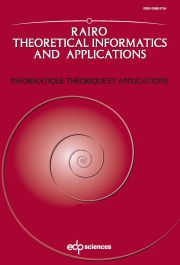Crossref Citations
This article has been cited by the following publications. This list is generated based on data provided by Crossref.
Glen, Amy
Levé, Florence
and
Richomme, Gwénaël
2008.
Quasiperiodic and Lyndon episturmian words.
Theoretical Computer Science,
Vol. 409,
Issue. 3,
p.
578.
Glen, Amy
and
Justin, Jacques
2009.
Episturmian words: a survey.
RAIRO - Theoretical Informatics and Applications,
Vol. 43,
Issue. 3,
p.
403.
Richomme, Gwénaël
Saari, Kalle
and
Zamboni, Luca Q.
2010.
Standard factors of Sturmian words.
RAIRO - Theoretical Informatics and Applications,
Vol. 44,
Issue. 1,
p.
159.
Medková, Kateřina
2019.
Combinatorics on Words.
Vol. 11682,
Issue. ,
p.
251.
Richomme, Gwenaël
2021.
On sets of indefinitely desubstitutable words.
Theoretical Computer Science,
Vol. 857,
Issue. ,
p.
97.
Berthé, Valérie
and
Goulet-Ouellet, Herman
2024.
Obstructions to Return Preservation for Episturmian Morphisms.
Theory of Computing Systems,
Vol. 68,
Issue. 6,
p.
1512.
Berthé, V.
and
Puzynina, S.
2025.
On the rigidity of Arnoux-Rauzy words.
Advances in Applied Mathematics,
Vol. 170,
Issue. ,
p.
102932.

